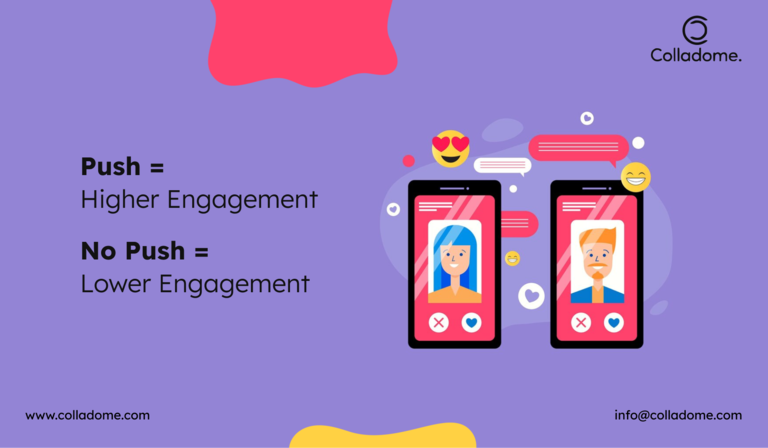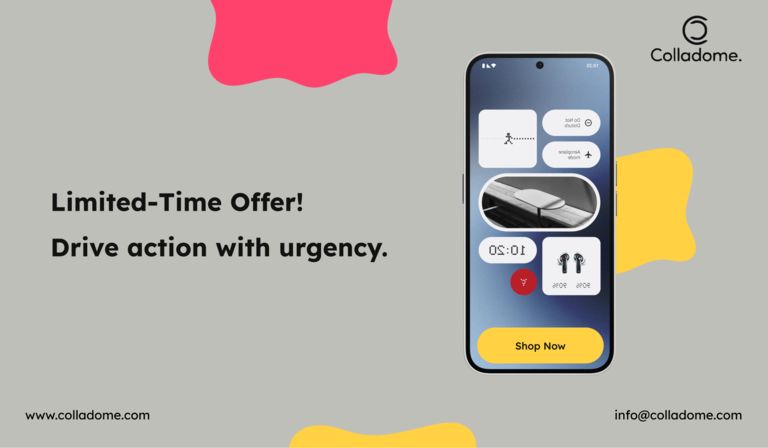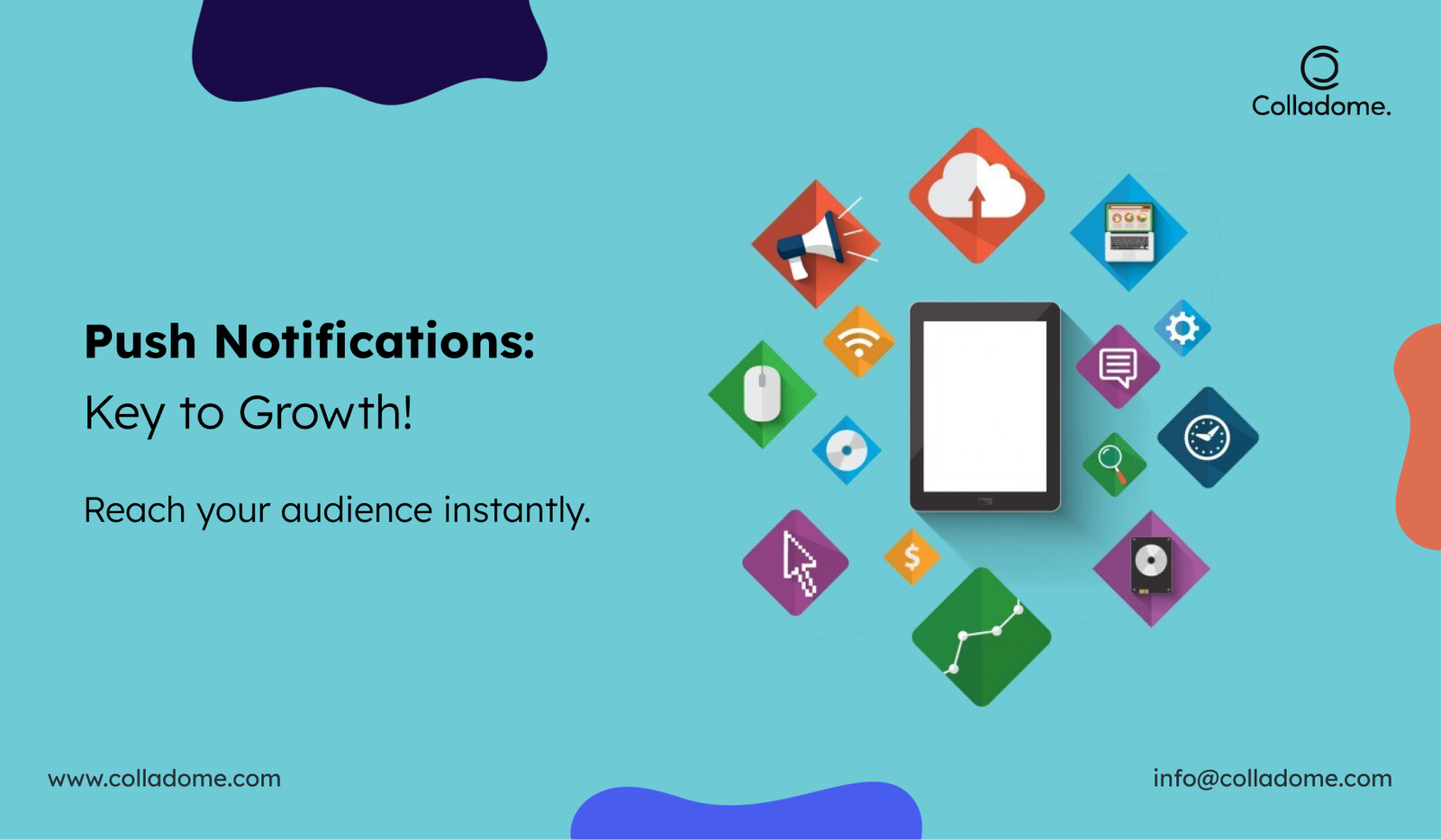In a world where attention is currency, push notifications are the tools that help you win!
In today’s digital age, how can businesses cut through the noise and reach customers? Enter push notifications! These are a direct channel for businesses to connect with users at key moments, driving engagement, conversion, and loyalty. But did you know that push notifications and push notifications, while often interchangeable, are different? They are powerful tools with different scopes and uses.
Understanding and leveraging push notifications is no longer optional—it’s essential! Businesses that don’t use them effectively may find it challenging to stay relevant in this hyper-competitive market. So, what exactly are push notifications? They provide a way to communicate with your audience in a non-intrusive manner while adding real value. Imagine sending real-time updates and personalized reminders that resonate with users!
This blog explores the importance of push notifications. It covers their impact on business and how to maximize their effectiveness for your organization. Ready to dive in? Let’s go!

What is a Push Notification?
Ever been browsing your phone and suddenly a little alert pops up? That’s a push notification! 🎉 It’s like a friendly tap on the shoulder from an app, letting you know something important or exciting is happening. Whether it’s a reminder about a sale, an update on your order, or a new message, push notifications help keep you in the loop!
These alerts can appear on your mobile device or browser, even when you’re not actively using the app. They’re designed to grab your attention without being intrusive—kind of like a helpful nudge saying, “Hey, don’t forget about me!” So, next time you see one, think of it as your app’s way of staying connected with you!
Push Signal vs. Push Notification: A Handy Distinction
While the terms are often used interchangeably, push notifications and push notifications are slightly different:
- Push Signal: This is a broad term for automated messages. They include in-app messages, reminders, alerts, and updates. They aim to re-engage users. These signals provide actionable insights or timely prompts to keep users actively engaged.
- Push Notification: This is a type of push signal. It typically appears as a banner, alert, or pop-up on the user’s screen, either on their mobile device or browser. It’s more immediate and appears outside the app, catching attention even when users aren’t actively browsing.

| Scenario | With push notifications | Without push notifications |
| User Engagement | Increased engagement due to timely reminders and re-engagement prompts | Limited engagement, relying solely on the user’s initiative to open the app |
| User retention | Higher retention as notifications remind users of the app’s value | Lower retention as users may forget about the app or lose interest |
| Timeliness | Users receive immediate updates or alerts even when not actively using the app | Users may miss timely updates and only see them upon manually checking the app |
| Re-engagement opportunities | Easier to re-engage the users through alerts for special offers, updates, and new features | Harder to re-engage users who are not actively opening the app |
| Brand awareness | Enhanced brand visibility through regular notifications appearing on user device | Reduce brand visibility without proactive outreach, leading to possible disinterest |
Why Are Push Notifications Essential for Modern Businesses?
The importance of push notifications is far-reaching, with applications that benefit businesses of all sizes. Here’s a closer look at why push notifications have become indispensable in the modern business environment:
Increased User Engagement
- push notifications are frequent touchpoints. They encourage users to interact with content. This fosters loyalty and attachment to the brand.
- A good push strategy can engage users. It should use personalized, timely messages. They must feel relevant and valuable, not intrusive.
Boosts Conversion Rates
- By sending targeted messages at the right time, push notifications can encourage users to make purchasing decisions.
- Recent Statista data shows that segmenting push notifications by user behavior can boost conversion rates by 30%.
Enhances Customer Retention
- push notifications are highly effective for customer retention. Clevertap reported in 2023 that push notifications can boost app customer retention by 50% in 90 days.
Real-Time Communication
- push notifications let businesses communicate with customers instantly. This is key for eCommerce. Timely updates on restocks, discounts, and order tracking can greatly affect customer satisfaction.
How Push Notifications Operate: The Technology Behind the Scenes
Despite their seemingly simple nature, push notifications rely on sophisticated technology. Platforms like OneSignal have made this tech accessible to all businesses. They offer easy-to-use solutions for automation, segmentation, and analytics. These tools let businesses send push notifications efficiently. This boosts engagement without overwhelming users.
Key Elements of Push Signal Technology
- User Opt-In push notifications require user consent: Individuals must choose to receive notifications. This opt-in process creates a self-selected audience. They are genuinely interested in updates. So, each message is more likely to resonate.
- Message Segmentation: Segmentation lets businesses divide their audience into groups. They use user data like behavior, demographics, and preferences. For example, an e-commerce site might group users as “frequent buyers” or “first-time shoppers.” It could then send relevant messages to each group.
- Delivery Optimization: Timing is key. Advanced algorithms analyze user activity patterns. They find the best times to deliver notifications. By adjusting delivery to user behaviors, businesses can boost message open rates and actions.
- Analytics and Tracking: Robust analytics are essential to any push strategy. Metrics like open rates, click-through rates, and conversions give insights. They help businesses know what’s working and what’s not. With this data, companies can continually refine their messaging to enhance user engagement.
Best Practices for Using Push Notifications in Business
To make push notifications effective, businesses must adopt audience-focused strategies. These should consider the audience’s preferences and behavior. Here are the best practices that can help:
Segmentation is Key
- Using user data, like location and browsing history, to tailor messages can create very personalized content. This is more likely to engage users. OneSignal reports that push notifications targeting specific segments have 4x higher click-through rates.
Timing Matters
- Send notifications when your audience is most active. Messaging at peak hours can boost engagement. Many push platforms, like OneSignal, automate delivery. They do this to maximize visibility by using user activity patterns.
Personalization Enhances Engagement
Using the user’s name, suggesting products from past purchases, or offering exclusive deals for loyal customers can make messages more relatable. A/B testing can also help determine which message format resonates best.
Limit Frequency to Prevent Fatigue
- Avoid overwhelming users by limiting notifications to a maximum of two per day. Studies suggest that too many notifications can raise opt-out rates. Up to 40% of users disable notifications when flooded with irrelevant messages.
Real-World Examples of Successful Push Signal Implementations
Flipkart (India)
- The Indian eCommerce giant Flipkart uses personalized push notification. They aim to engage users with exclusive offers, discounts, and abandoned cart reminders. Their push signal strategy has increased user engagement by 20%. It does this by ensuring customers get timely updates on products they care about. (source)
Zomato (India)
- Zomato uses location-based push notifications to inform users of nearby restaurant deals. Zomato’s efforts boosted daily orders by 30%. They also improved the user experience with relevant, location-based suggestions. (source)
Amazon (Global)
- Amazon’s personalized push notification have helped it retain customers. They are based on customers’ browsing and purchase history. This personalization has increased customer retention by 12% year-on-year. It proves that tailored notification can create lasting connections. (source)
Starbucks (Global)
- Starbucks’ loyalty program uses push notification to remind users of rewards and special offers. This strategy has doubled the program’s participation. It boosted loyalty and repeat visits.
Statistics and Key Insights
| Feature | Statistic | Source |
| Increased conversion rates | 30% | Statista |
| Customer retention boost | 50% in the first 90 days | Clevertap |
| Engagement through segmentation | 4x higher click-through rate | OneSignal |
| Optimal notification frequency | 2 notifications/day | Mobile Marketer |
The Role of push notifications in Modern eCommerce and Marketing
push notification can greatly benefit eCommerce. Timely communication can boost revenue. They bridge businesses and their audience. They provide updates, offers, and abandoned cart reminders to bring users back to complete purchases.
Push Notifications for Websites and Mobile Apps
- Engages users on mobile and desktop alike, helping websites and apps reach customers instantly. Free web push notification services are great for small businesses. They help keep users engaged at a low cost.
Push Marketing: A Key Strategy for Small Businesses
- For budget-conscious businesses, push notifications are a cheap way to boost sales without high ad costs. Small businesses can use web push notification to keep customers informed and engaged. This will help bring them back.
Marketing Strategies to Increase Sales Using Push Notifications
- Incorporating push notification into broader marketing strategies can amplify their effectiveness. For example, running limited-time offers and using push notifications can boost short-term sales. They encourage users to act quickly.

Conclusion:
push notifications are more than just communication tools. They are a vital strategy for any business that wants to succeed in the digital world. push notification help businesses engage customers and boost conversion rates. With smart segmentation, timing, and personalization, they build brand loyalty. Platforms like OneSignal make it easy to use push notifications. They help businesses of all sizes meet their marketing and engagement goals.
Can push notification be used for customer feedback and engagement?
- Yes, push notifications can effectively solicit customer feedback and engage users. Businesses can send push notification requesting reviews or inviting customers to participate in surveys. This feedback helps improve products and services while making customers feel valued.
How can businesses measure the success of their push signal campaigns?
- Businesses can measure the success of push signal campaigns through various metrics, including open rates, click-through rates (CTR), and conversion rates. Analyzing these metrics allows companies to assess user engagement, optimize future campaigns, and refine their messaging strategies.
Are there any risks associated with using push notifications?
- While push notification can enhance engagement, there are risks if not managed properly. Overloading users with too many notifications can lead to opt-outs and decreased engagement. It’s crucial to maintain a balance in frequency and ensure that messages are relevant and valuable to avoid user fatigue.








